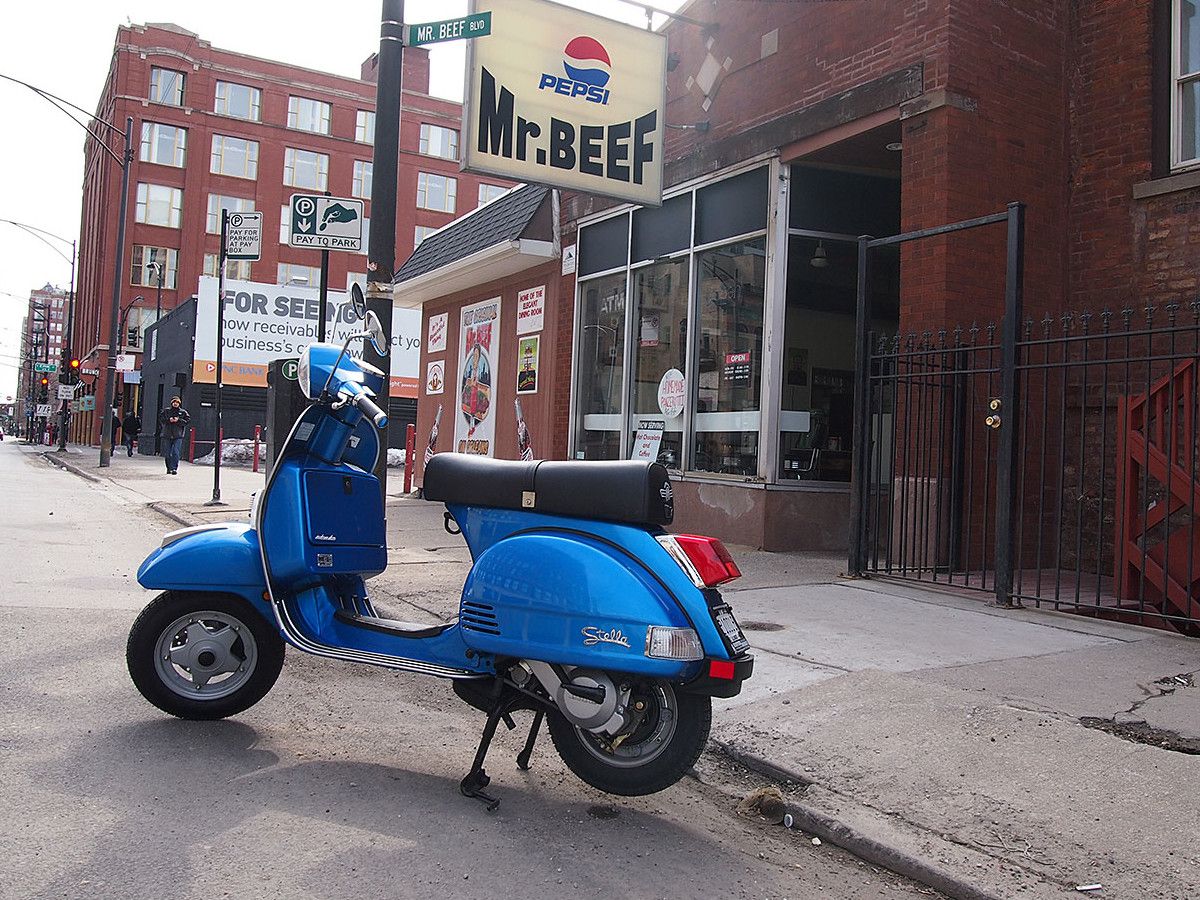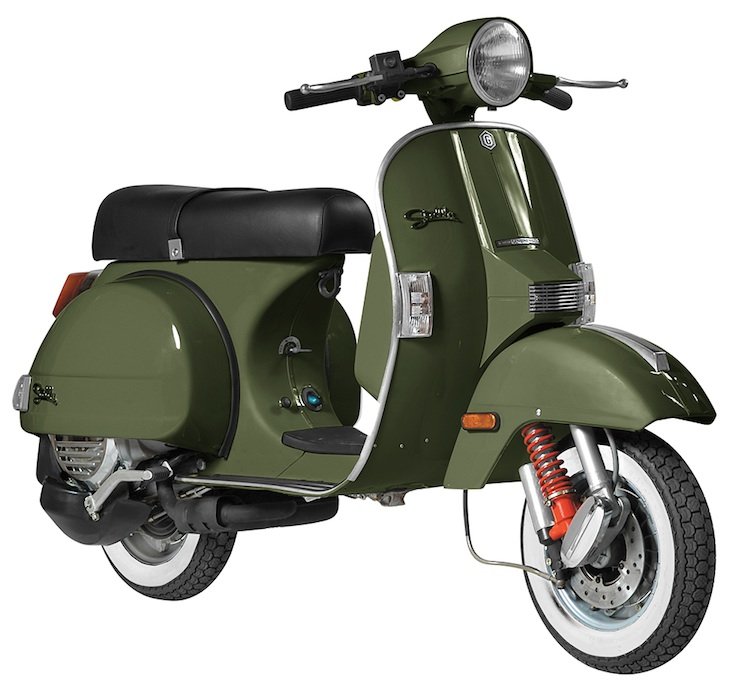GENUINE STELLA
The Stella was first introduced under the Genuine name in 2003, but its lineage can easily be traced back to Vespa’s PX design that was crafted in the late 70’s. The Stella isn’t a modern scooter wearing retro clothes, it’s a true vintage scooter that remained in production for several decades until 2017 when its manufacturer (LML) went out of the scooter business.
The Stella was imported to the USA with 2-stroke power in several batches in the early years. The only state to miss out was California with its most stringent regulations. The 2-stroke Stella 150 was usually available in 2003-2006 and then again in 2008 and 2009. Genuine made a few tweaks to the Stella for 2008 including the inclusion of their ‘Bad Boy’ super horn and a few fit and finish improvements.
Genuine intended to replace the hard to import 2-stroke Stella with a cleaner burning 4-stroke Stella for 2010, but import and customs delays meant these 4-stroke Stella’s didn’t make it to showrooms until 2011. The good news was that this cleaner 4-stroke scooter went on sale in California and up in Canada for the first time, although it was only imported to Canada via one or two small shops for a few years (2011 – 2015).
The 4-stroke Stella continued to be sold in the USA, and for 2014, Genuine debuted an automatic version of their Stella using a smaller 125cc motor. This latest revision moves the spare tire over to the right flank to make room for a modern CVT. This model was sold until early 2017, at which point LML that manufacturers these scooters in India ran into financial problems and had to shut down their two wheeler manufacturing, bring the Stella’s 15 year run to a sudden end.
Model Background
After Vespa developed the PX design in the 70’s, they partnered with Indian based manufacturer LML (amongst others) to manufacture the scooters. LML ended up becoming the largest manufacturing arm of Vespa for their PX line of scooters throughout its hey-day in the 80’s. All of the PX engines and most of the frames where built at the LML plant in India during this period. Since it was their largest PX production facility, Piaggio had their latest engine designs only at the LML plant, so when the two companies parted ways in 2000, LML was left with the most technological up to date equipment and designs for Piaggio’s PX line, as well as the rights to continue to use them.
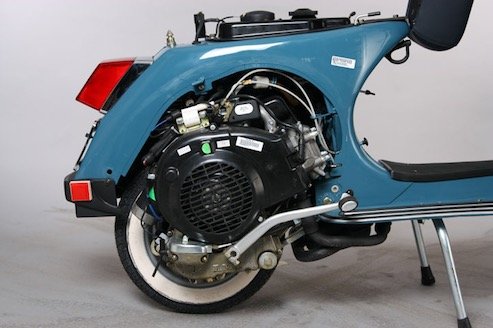
Engines
From 2003 through 2009, all Stella’s were powered by the PX’s traditional motor – a 150cc 2-stroke. Unlike the batch of PX scooters Vespa brought to North America in 2005, only the Stella used the newer reed cage instead of the older rotary design. The motor offered reasonable fuel economy for a large 2-stroke and a top speed of 55mph. In some forms this engine is a bit faster, but compliance with American emissions regulations doesn’t go hand in hand with maximizing the power output of a large 2-stroke. Numerous performance modifications are available for the speed inclined, as the PX is one of the most popular scooters ever and thus enjoys a vibrant and diverse aftermarket scene.
The 4-stroke engine found in the 2011 and newer models is a 147.55cc design from LML that offers 8.3 HP and a top speed around 60mph. This 4-stroke motor easily wins for fuel milage and emissions, and it offers similar power as the engine it replaced because of emissions constants required on the 2-stroke mill. If you’re looking to modify an engine for racing speeds the 2-stroke has more potential, but the 4-stroke offers a similar amount of power and it can also be upgraded so everyone but racers and true PX purists will find the 4-stroke to be a nice choice.
Design and Amenities
The Stella offers a generous sized glovebox, which mostly makes up for the lack of underseat storage. Obviously you’re not going to fit your helmet in here, but pretty much anything else will fit as this glovebox is larger than pretty much any other scooter.
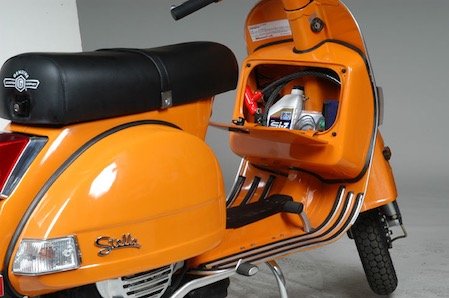
The huge worldwide popularity of the PX design means there’s abundant accessories available from this scooter. The plethora of aftermarket companies will happily sell you a diverse range of accessories that run the gamut from chrome tidbits to fire breathing big bore kits.
Since its introduction, the Stella has been available in a range of tasteful colors. Red, Slate Blue and Avocado seem to be the most popular, but there’s something for everyone with Genuine offering the 2-stroke Stella in five colors and the newer 4-stroke Stella in 5 colors plus 2 two tone color schemes. The Avocado Stella was the only 2-stroke to get white walls tires, but the 4-stroke Stella’s all use white walls irrespective of pigment choice.
Comparison
The most obvious competitor to the Stella is modern times was the 1500 PX150 scooters that Vespa released in a limited batch in 2004. These scooters were available from dealers in the USA and Canada for several years, but by 2007 they were mostly sold out. The Vespa PX 150’s used a slightly older version of this 2-stroke motor but for the most part it was the same machine as the Stella, albeit assembled in different factories. The Stella saved you about a $1000 on the initial purchase price and offered the updated motor, while the Vespa’s sported that well known wasp name.
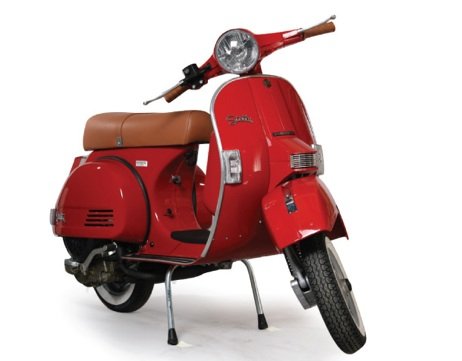
If you’re after a true vintage scooter, the Stella (or a used machine) is really the only way to go. If you simply like the idea of a vintage styled scooter but don’t necessarily want the other aspects that come with a 35 year old design, then lots of companies sell newer scooters with a retro look. Kymco offers the Like 200 in the USA and the New Sento 110i in Canada. Vespa sells their LX 150 and S 150 models and until recently Yamaha was selling the Vino 125.
Pros:
- Most technologically advanced PX design (ie. reed vs. rotary valve)
- Low purchase price for a true PX design
- Awesome selection of colors
- Cavernous glovebox
Cons:
- Lower resale value than a Vespa branded PX
- No underseat storage
Links:
Service Manual for the 2-stroke Stella – Super helpful for the DIY mechanic
4-stroke Stella Service Manual – Great resource for the home mechanic
MotorscooterGuide Forums – Visit the forums on this site to chat about this scoot.
4-stroke Stella Review – Nice detailed write up by Motorcycle-USA
ScooterFile – Best review of the 4-stroke Stella
Key Specs:
- Engine: 125cc air-cooled 4-stroke or 150cc 2-stroke, air-cooled single or 147cc air-cooled 4-stroke
- Power: 8.0 HP @ 5500 RPM (2-stroke), 8.3 HP (147cc 4-stroke)
- Transmission: 4 speed manual or CVT
- Bore & Stroke: 57.8 x 57.0mm (2-stroke)
- Fuel Delivery: Carb
- Wheelbase: 48.6”
- Weight: 240 lbs (2-stroke), 260 lbs (4-stroke), 256 lbs (Automatic 125cc 4-stroke)
- Starter: Electric and Kick
- Seat height: 32.3”
- Fuel Tank: 2.1 gallon
- Oil Tank: 0.26 gllon
- Front Brake: Hydraulic Disc
- Rear Brake: 6” Drum
- Front Suspension: Trailing Link, Gabriel
- Rear Suspension: Single Gabriel Shock
- Tires: 3.5 x 10” (Front and Rear)
- USA MSRP: $3499 – $3699
Colors:
- 2003-2006 (2-stroke): Red, Black, Tangerine, Avocado, Powder Blue
- 2008-2009 (2-stroke): Red, Black, Orange, Avocado, Light Blue
- 2011-2015 (4-stroke): Slate Blue, Avocado, Creme, Red, Dijon Yellow, Black, Creme/Slate Blue, Creme/Avocado
- 2014-2017 (125 Auto): Candy Apple Red, Black, Ivory, Electric Blue

